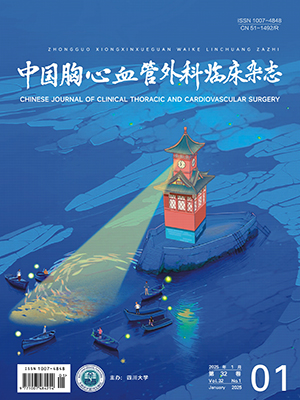| 1. |
管玉龙, 万彩红, 董培青, 等. 直肠温度25℃时停循环选择性脑灌注的探讨. 中华胸心血管外科杂志, 2009, 25(6): 390-392.
|
| 2. |
万彩红, 刘晓军, 韩敬梅, 等. 中低温选择性脑灌注对肝肾功能的影响. 中国体外循环杂志, 2010, 8(2): 75-78.
|
| 3. |
Shrestha M, Martens A, Krüger H, et al. Total aortic arch replacement with the elephant trunk technique: single-centre 30-year results. Eur J Cardiothorac Surg, 2014, 45(2): 289-295.
|
| 4. |
Gong M, Ma WG, Guan XL, et al. Moderate hypothermic circulatory arrest in total arch repair for acute type A aortic dissection: clinical safety and efficacy. J Thorac Dis, 2016, 8(5): 925-933.
|
| 5. |
Takagi H, Umemoto T, Alice G. A Meta-analysis of total arch replacement with frozen elephant trunk in acute type a aortic dissection. Vasc Endovascular Surg, 2016, 50(1): 33-46.
|
| 6. |
Garg V, Ouzounian M, Peterson MD. Advances in aortic disease management: a year in review. Curr Opin Cardiol, 2016, 31(2): 127-131.
|
| 7. |
Rice RD, Sandhu HK, Leake SS, et al. Is Total arch replacement associated with worse outcomes suring repair of acute type a aortic dissection? Ann Thorac Surg, 2015, 100(6) :2159-2165.
|
| 8. |
Peterson MD, Mazine A, El-Hamamsy I, et al. Knowledge, attitudes, and practice preferences of Canadian cardiac surgeons toward the management of acute type A aortic dissection. J Thorac Cardiovasc Surg, 2015, 150(4): 824-831, e1-5.
|
| 9. |
Urbanski PP, Irimie V, Wagner M. Cannulation and perfusion strategy in acute aortic dissection involving both common carotid arteries. Interact Cardiovasc Thorac Surg, 2015, 21(4): 557-559.
|
| 10. |
Okita Y, Matsumori M, Kano H. Direct reperfusion of the right common carotid artery prior to cardiopulmonary bypass in patients with brain malperfusion complicated with acute aortic dissection. Eur J Cardiothorac Surg, 2016, 49(4): 1282-1284.
|
| 11. |
Urbanski PP, Lenos A, Kolowca M, et al. Near-infrared spectroscopy for neuromonitoring of unilateral cerebral perfusion. Eur J Cardiothorac Surg, 2013, 43(6): 1140-1144.
|
| 12. |
Bokeriia LA, Arakelian VS, Shchanitsyn IN, et al. First experience with monitoring somatosensory and motor evoked potential during operations on the thoracic and thoracoabdominal portions of the aorta. Angiol Sosud Khir, 2012, 18(3): 138-146.
|
| 13. |
Shimizu H, Matayoshi T, Morita M, et al. Total arch replacement under flow monitoring during selective cerebral perfusion using a single pump. Ann Thorac Surg, 2013, 95(1): 29-34.
|
| 14. |
Habertheuer A, Wiedemann D, Kocher A, et al. How to perfuse: concepts of cerebral protection during arch replacement. Biomed Res Int, 2015, 2015, 98: 1813.
|
| 15. |
Neumann A, Koigeldiyev N, Shrestha M, et al. Complex aortic arch repair in a patient with Takayasu’s disease presenting with acute aortic dissection type Stanford A and complete collateral perfusion of the brain. Interact Cardiovasc Thorac Surg, 2016, 22(3): 384-386.
|
| 16. |
Chu MW, Losenno KL, Gelinas JJ, et al. Innominate and Axillary Cannulation in Aortic Arch Surgery Provide Similar Neuroprotection. Can J Cardiol, 2016, 32(1):117-123.
|
| 17. |
Agostini M, Di Gregorio V, Bertora M, et al. Near-infrared spectroscopy-detected cerebral ischemia resolved by cannulation of an axillo-femoral graft during surgical repair of type A aortic dissection.Heart Surg Forum, 2012, 15(4): E221-E223.
|
| 18. |
Urbanski PP, Babin-Ebell J, Fröhner S, et al. Insufficient unilateral cerebral perfusion during emergent aortic arch surgery. Interact Cardiovasc Thorac Surg, 2012, 14(1): 122-124.
|
| 19. |
张科峰, 徐东, 华扬. 经颅超声监测在主动脉夹层手术中的应用. 中国胸心血管外科临床杂志, 2011, 18(2): 146-148.
|
| 20. |
Ghazy T, Darwisch A, Schmidt T, et al. Transcranial doppler sonography for optimization of cerebral perfusion in aortic arch operation. Ann Thorac Surg, 2016, 101(1): e15-e16.
|




